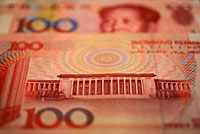




China’s growing hard currency reserves have topped U.S. $1 trillion, but the low value of the country’s own currency, the yuan, continues to cause concern.
On Nov. 6, China’s State Administration of Foreign Exchange (SAFE) announced that China’s foreign reserve holdings had topped the U.S. $1 trillion mark for the first time, according to Agence France-Presse.
The next day, a SAFE spokeswoman denied that any statement had been issued, but the news had been expected since the end of September, when the People’s Bank of China (PBOC) reported reserves valued at U.S. $987.9 billion.
The PBOC is believed to hold about 70 percent of its reserves in U.S. dollars, with the rest in euros and other Western currencies, The Wall Street Journal reported last month.
The consequence of that is you get a very large reserve buildup. So in order to stop the reserve buildup, they need to change the exchange rate.
At the end of 2002, when economists began to take notice of the rise in China’s reserves, the country’s holdings stood at U.S. $286 billion, according to PBOC reports.
The next year, they rose to U.S. $403 billion. By the end of 2004, they reached U.S. $610 billion, and then topped U.S. $818 billion in 2005.
U.S. manufacturers and other foreign observers have claimed that this rise in the value of reserves has been due not only to China’s own rapid economic growth, but to its efforts to manage the exchange rate of the yuan.
In interviews with Radio Free Asia, economists offered differing views of the progress that China has made with its currency controls.
Morris Goldstein, senior fellow at the Washington-based Peterson Institute for International Economics, attributed the climb in China’s reserves to “a vastly undervalued exchange rate—an exchange rate that’s somewhere between 20 and 35 percent undervalued.”
“The consequence of that is you get a very large reserve buildup,” Goldstein said. “So in order to stop the reserve buildup, they need to change the exchange rate.”
Goldstein said that China’s large reserve holdings have become a problem because cash is being pushed into the country’s economy by banks in the form of loans.
This has created a surge in investment and environmentally harmful construction which the government has been trying to stop.
“It does create problems for them because it makes it harder to keep control over bank lending. It makes it harder to control investment rate policy, which in turn makes it harder to control the excessive rate of investment.”
“The solution,” Goldstein said, “is to move the exchange rate. They keep talking about it, but they don’t actually do it.”
Though a stronger yuan would mean that the PBOC’s dollars would be worth less, the value of citizens’ savings in yuan would go up, Goldstein added.
Harvard economist Dale Jorgenson pointed out that other growing economies have taken on similar challenges in the past. “The Chinese are not the first to face this kind of problem,” he said.
“The people in Singapore had a problem like this about 20 years ago. They accumulated about U.S. $200 billion in reserves, and they decided that they wanted to make that into a permanent fund, which they have managed to keep at roughly that level as a kind of an endowment for various programs that satisfy certain social needs.”
One advantage of setting the money aside in a fund is that it would not be immediately spent. This would reduce the risk of excessive investment, economic overheating, and inflation, Jorgenson said.
Jorgenson suggested that a portion of China’s reserves could be used to shore up the country’s social security fund, which is seriously underfinanced. He also agreed that China should allow the value of the yuan to rise, but said that this should occur “on a gradual basis” instead of as a sudden change.
China should adopt a mechanism called the “crawling peg,” Jorgenson said. This would peg the yuan’s value to the dollar while allowing for an upward adjustment by a set percentage each month.
“Crawling pegs” were widely used to adjust currency values at predictable rates in Eastern Europe and Russia during the 1990s, Jorgenson said.
Original reporting by Michael Lelyveld. Edited for the Web by Richard Finney.